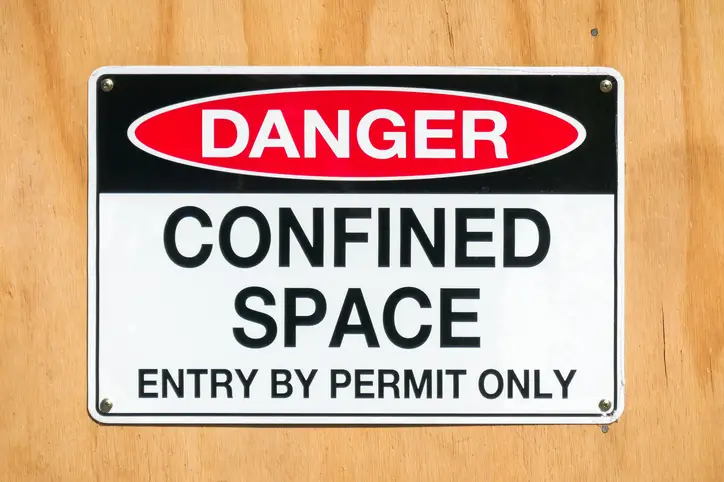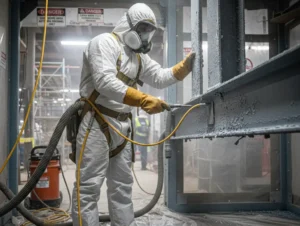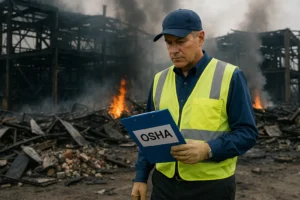⚠️ Confined Space Hazards: A Silent Threat
Health and safety hazards are common in the everyday lives of people working in various industries. However, confined space hazards seem to be the most underrated cause of fatalities among workers.
This article presents a clear understanding of the risks involved when interacting with confined spaces and explains the emergency procedures and approaches to address emergencies.
📦 What is Defined as a Confined Space?
A confined space refers to an area that is partially or fully enclosed, not intended for continuous human occupancy, and can pose serious health and safety risks. While it might be small and awkward to access, OSHA has a specific definition for confined spaces.
According to OSHA, a confined space is a space:
- 🧍 Has limited or restricted entry and exit access
- 🏗️ Is not designed for continuous human occupancy
- 🛠️ Allows a worker to enter and perform tasks inside the space
Examples include wells, silos, tunnels, tanks, and bins. These areas may expose workers to life-threatening risks such as low oxygen levels, toxic gases, fire, explosion, or structural collapse.
📂 Types of Confined Spaces
Confined spaces are generally classified into three main categories. This section focuses on the first and most critical: Permit-Required Confined Space.
🚷 Permit-Required Confined Space
A permit-required confined space refers to an enclosed area that poses significant health or safety risks to entrants and is governed by strict OSHA entry procedures. These areas are clearly marked with warning signage and require a documented entry plan to ensure safety.
According to OSHA, a space is classified as permit-required if it meets one or more of the following risk criteria:
- 💨 Contains or could contain a hazardous atmosphere
- 🌊 Holds material that could engulf an entrant
- 📏 Has a structure that may trap or suffocate entrants due to inwardly converging walls or sloping floors
- 🧯 Includes any serious safety or health risk (e.g., mechanical, electrical, chemical hazards)
💨 Hazardous Atmosphere
A confined space may contain a hazardous atmosphere that poses an immediate or long-term risk to health. These risks can arise from:
- 🔻 Oxygen-deficient environments
- 🔥 Flammable gases, vapors, or dust
- ☠️ Toxic or harmful substances like hydrogen sulfide or carbon monoxide
These atmospheres can cause asphyxiation, poisoning, explosions, or fire making air testing and ventilation essential before entry.
🌊 Engulfment Hazard
A confined space may contain loose materials such as liquids, sand, or grain that can engulf and suffocate a worker with little or no warning.
Engulfment can occur rapidly, offering minimal time for escape. Common examples include:
- 🌾 Grain silos with shifting content
- 🚰 Water tanks or slurry pits
- 🪨 Loose bulk materials like coal, sand, or chemicals
Once submerged, escape becomes extremely difficult, making hazard awareness and proper equipment critical.
📏 Internal Configuration Hazard
Certain confined spaces have narrow, sloped, or irregular shapes that can trap or asphyxiate entrants. These configurations restrict movement and make it difficult to escape quickly in emergencies.
This hazard is especially critical in environments such as:
- 🛢️ Pipelines with limited crawl space
- 📦 Vaults or tanks with tapered bases
- 🧱 Storage units with irregular floor or wall angles
Limited access and exit points increase response time during rescues and heighten the risk of suffocation or injury.
🧯 Other Serious Hazards
Confined spaces may contain a range of additional hazards that can cause serious injury or long-term health effects if not identified and controlled.
These may include:
- ⚡ Mechanical or electrical hazards from unguarded or energized equipment
- 🌡️ Extreme temperatures that can lead to burns, heat stroke, or hypothermia
- 🔊 High noise levels that impair communication and cause hearing loss
- ☠️ Chemical exposure through vapors, spills, or residues
These risks require careful planning, hazard assessments, and appropriate PPE to ensure worker safety.
🚪 Alternate (Non-Permit) Confined Space
Non-permit-required confined spaces may lack the acute risks of permit-required areas, but still demand thoughtful precaution. These spaces do not exhibit hazardous atmospheres, engulfment threats, or entrapment risks, yet restricted access alone justifies safety planning.
Employers should consider the following practices:
- ✅ No signage or attendant required by OSHA
- 📢 Employees must be notified of the space’s existence
- 🛠️ Develop a safety plan to prepare for unforeseen incidents
- 📊 According to NASP, truly non-permit spaces are rare due to the prevalence of qualifying hazards
These areas may appear less dangerous but must be approached with the same respect for worker safety to prevent complacency-related accidents.
⚠️ 7 Hazards Associated With Confined Spaces
Working in confined spaces introduces serious and often overlooked dangers. These hazards underscore the critical importance of receiving confined space training to ensure safety and preparedness.
From toxic atmospheres to restricted access, each risk requires proactive safety measures to prevent injury or fatal incidents. Below are seven key confined space hazards you need to recognize and prepare for.
💨 Lack of Oxygen
In 2014, three workers at the Google Docks lost their lives due to oxygen levels as low as 5-6%. Naturally occurring reactions can deplete oxygen and produce harmful carbon dioxide, posing a fatal risk.
🧪 Gases, Fumes & Vapors
Toxic gases can enter through leaks or be created during tasks like welding or painting. Poor ventilation in confined spaces quickly turns breathable air into a toxic trap.
🌊 Flooding
Rapid flooding from sewer work or shifting solids can drown or bury workers. Small confined areas can become deadly within seconds without immediate evacuation options.
🌪️ Dust
Dust from drilling, grinding, or natural accumulation can cause fatal respiratory issues. It also heightens explosion risks in poorly ventilated spaces.
🔥 Fire & Explosions
Flammable vapors, dust, and tools that produce sparks increase the chances of combustion. High oxygen levels further intensify the risk without control measures in place.
🌡️ Temperature
Heat from physical work or enclosed machinery can cause heatstroke or collapse. Without temperature regulation, workers are at risk even in short exposures.
🚪 Access Restrictions
Narrow or limited entry points delay rescue and hinder evacuation. Every confined space entry must include a reliable emergency response plan.
✅ Wrap Up
Given the serious hazards present in confined spaces, it's crucial for employees to undergo proper training. OSHA Confined Spaces Online Training Courses provide essential knowledge on the various types of risks, precautionary measures, and the use of personal protective equipment.
By participating in these training programs, workers can confidently and safely perform their duties in confined environments, protecting their health and potentially saving lives. Encourage your team to get trained and stay safe.






